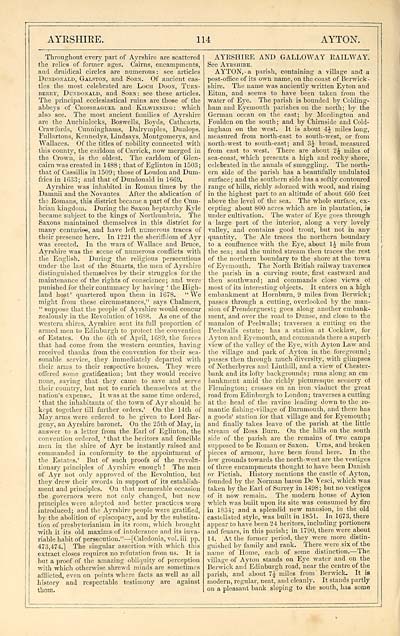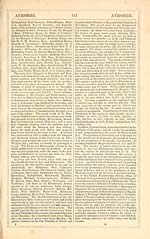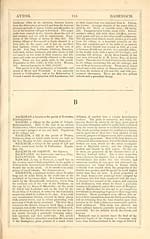Download files
Complete book:
Individual page:
Thumbnail gallery: Grid view | List view

AYRSHIRE.
114
AYTON.
Throughout every part of Ayrshire are scattered
the relies of former ages. Cairns, encampments,
and dmidical circles are numerous: see articles
Dundonald, Galston, and Sons. Of ancient cas-
tles the most celebrated are Loch Doon, Tuen-
beery, Dundonald, and Soen : see these articles.
The principal ecclesiastical ruins are those of the
abbeys of Crossraguel and Kilwinning: which
also see. The most ancient families of Ayrshire
are the Auchinlecks, Boswells, Boyds, Cathcarts,
Crawfords, Cunninghams, Dalrymples, Dunlops,
Fullartons, Kennedys, Lindsays, Montgomeiys, and
Wallaces. Of the titles of nobility connected with
this county, the earldom of Carrick, now merged in
the Crown, is the oldest. The earldom of Glen-
cairn %vas created in 1488 ; that of Eglinton in 1503;
that of Cassillis in 1509; those of Loudon and Dum-
fries in 1633; and that of Dundonald in 1669.
Ayrshire was inhabited in Kornan times by the
Damnii and the Novantes After the abdication of
the Bomans, this district became a part of the Cum-
brian kingdom. During the Saxon heptarchy Kyle
became subject to the longs of Northumbria. The
Saxons maintained themselves in this district for
many centuries, and have left numerous traces of
their presence here. In 1221 the sheriffdom of Ayr
was erected. In the wars of Wallace and Bruce,
Ayrshire was the scene of numerous conflicts with
the English. During the religious persecutions
under the last of the Stuarts, the men of Ayrshire
distinguished themselves by their straggles for the
maintenance of the rights of conscience ; and were
punished for their contumacy by having ' the High-
land host' quartered upon them in 1678. "We
might from these circumstances," says Chalmers,
" suppose that the people of Ayrshire would concur
zealously in the Revolution of 1688. As one of the
western shires, Ayrshire sent its full proportion of
armed men to Edinburgh to protect the convention
of Estates. On the 6th of April, 1689, the forces
that had come from the western counties, having
received thanks from the convention for their sea-
sonable service, they immediately departed with
their arms to their respective homes. They were
offered some gratification; but they would receive
none, saying that they came to save and serve
their country, but not to enrich themselves at the
nation's expense. It was at the same time ordered,
1 that the inhabitants of the town of Ayr should be
kept together till further orders.' On the 14th of
May arms were ordered to be given to Lord Bar-
geny, an Ayrshire baronet. On the 25th of May, in
answer to a letter from the Earl of Eglinton, the
convention ordered, ' that the heritors and fencible
men in the shire of Ayr be instantly raised and
commanded in conformity to the appointment of
the Estates.' But of such proofs of the revolu-
tionary principles of Ayrshire enough ! The men
of Ayr not only approved of the Revolution, but
they drew their swords in support of its establish-
ment and principles. On that memorable occasion
the governors were not only changed, but new
principles were adopted and better practices were
introduced; and the Ayrshire people were gratified,
by the abolition of episcopacy, and by the substitu-
tion of presbyterianism in its room, which brought
with it its old maxims of intolerance and its inva-
riable habit of persecution." — [Caledonia, vol. iii pp.
473,474.] The singular assertion with which this
extract closes requires no refutation from us. It is
but a proof of the amazing obliquity of perception
with which otherwise shrewd minds are sometimes
afflicted, even on points where facts as well as all
history and respectable testimony are against
them.
AYRSHIRE AND GALLOWAY RAILWAY.
See Ayrshire.
AYTON, -a parish, containing a village and a
post-office of its own name, on the coast of Berwick •
shire. The name was anciently written Eyton and
Eitun, and seems to have been taken from the
water of Eye. The parish is bounded by Colding-
hain and Eyemouth parishes on the north ; by the
German ocean on the east; by Mordington and
Foulden on the south; and by Chimside and Cold-
ingham on the west. It is about 4J miles long,
measured from north-east to south-west, or from
north-west to south-east; and 3 J broad, measured
from east to west. There are about 2£ miles of
sea-coast, which presents a high and rocky shore,
celebrated in the annals of smuggling. The north-
ern side of the parish has a beautifully undulated
surface ; and the southern side has a softly contoured
range of hiUs, richly adorned with wood, and rising
in the highest part to an altitude of about 660 feet
above the level of the sea. The whole surface, ex-
cepting about 800 acres which are in plantation, is
under cultivation. The water of Eye goes through
a large part of the interior, along a very lovely
valley, and contains good trout, but not in any
quantity. The Ale traces the northern boundary
to a confluence with the Eye, about 1J mile from
the sea ; and the united stream then traces the rest
of the northern boundary to the shore at the town
of Eyemouth. The North British railway traverses
the parish in a curving route, first eastward and
then southward; and commands close views of
most of its interesting objects. It enters on a high
embankment at Hornburn, 9 miles from Berwick;
passes through a cutting, overlooked by the man-
sion of Prenderguest; goes along another embank-
ment, and over the road to Dunse, and close to the
mansion of Peelwalls; traverses a cutting on the
Peelwalls estate; has a station at Cocklaw, for
Ayton and Eyemouth, and commands there a superb
view of the valley of the Eye, with Ayton Law and
the village and park of Ayton in the foreground ;
passes then through much diversity, with glimpses
of Netherbyres and Linthill, and a view of Chester-
bank and its lofty backgrounds ; runs along an em ■
baukment amid the richly picturesque scenery of
Flemington; crosses on an iron viaduct the great
road from Edinburgh to London; traverses a cutting
at the head of the ravine leading down to the ro-
mantic fishing-village of Bummouth, and there has
a goods' station for that village and for Eyemouth;
and finally takes leave of the parish at the little
stream of Ross Burn. On the hills on the south
side of the parish are the remains of two camps
supposed to be Roman or Saxon. Urns, and broken
pieces of armour, have been found here. In the
low grounds towards the north-west are the vestiges
of three encampments thought to have been Danish
or Pietish. History mentions the castle of Ayton,
founded by the Norman baron De Vesci, which was
taken by the Earl of Surrey in 1498 ; but no vestiges
of it now remain. The modern house of Ayton
which was built upon its site was consumed by fire
in 1834; and a splendid new mansion, in the old
castellated style, was built in 1851. In 1673, there
appear to have been 24 heritors, including portioners
and feuars, in this parish; in 1790, there were about
14. At the former period, they were more distin-
guished by family and rank. There were six of the
name of Home, each of some distinction. — The
village of Ayton stands on Eye water and on the
Berwick and Edinburgh road, near the centre of the
parish, and about 7J miles from Berwick. It is
modern, regular, neat, and cleanly. It stands partly
on a pleasant bank sloping to the south, has some
114
AYTON.
Throughout every part of Ayrshire are scattered
the relies of former ages. Cairns, encampments,
and dmidical circles are numerous: see articles
Dundonald, Galston, and Sons. Of ancient cas-
tles the most celebrated are Loch Doon, Tuen-
beery, Dundonald, and Soen : see these articles.
The principal ecclesiastical ruins are those of the
abbeys of Crossraguel and Kilwinning: which
also see. The most ancient families of Ayrshire
are the Auchinlecks, Boswells, Boyds, Cathcarts,
Crawfords, Cunninghams, Dalrymples, Dunlops,
Fullartons, Kennedys, Lindsays, Montgomeiys, and
Wallaces. Of the titles of nobility connected with
this county, the earldom of Carrick, now merged in
the Crown, is the oldest. The earldom of Glen-
cairn %vas created in 1488 ; that of Eglinton in 1503;
that of Cassillis in 1509; those of Loudon and Dum-
fries in 1633; and that of Dundonald in 1669.
Ayrshire was inhabited in Kornan times by the
Damnii and the Novantes After the abdication of
the Bomans, this district became a part of the Cum-
brian kingdom. During the Saxon heptarchy Kyle
became subject to the longs of Northumbria. The
Saxons maintained themselves in this district for
many centuries, and have left numerous traces of
their presence here. In 1221 the sheriffdom of Ayr
was erected. In the wars of Wallace and Bruce,
Ayrshire was the scene of numerous conflicts with
the English. During the religious persecutions
under the last of the Stuarts, the men of Ayrshire
distinguished themselves by their straggles for the
maintenance of the rights of conscience ; and were
punished for their contumacy by having ' the High-
land host' quartered upon them in 1678. "We
might from these circumstances," says Chalmers,
" suppose that the people of Ayrshire would concur
zealously in the Revolution of 1688. As one of the
western shires, Ayrshire sent its full proportion of
armed men to Edinburgh to protect the convention
of Estates. On the 6th of April, 1689, the forces
that had come from the western counties, having
received thanks from the convention for their sea-
sonable service, they immediately departed with
their arms to their respective homes. They were
offered some gratification; but they would receive
none, saying that they came to save and serve
their country, but not to enrich themselves at the
nation's expense. It was at the same time ordered,
1 that the inhabitants of the town of Ayr should be
kept together till further orders.' On the 14th of
May arms were ordered to be given to Lord Bar-
geny, an Ayrshire baronet. On the 25th of May, in
answer to a letter from the Earl of Eglinton, the
convention ordered, ' that the heritors and fencible
men in the shire of Ayr be instantly raised and
commanded in conformity to the appointment of
the Estates.' But of such proofs of the revolu-
tionary principles of Ayrshire enough ! The men
of Ayr not only approved of the Revolution, but
they drew their swords in support of its establish-
ment and principles. On that memorable occasion
the governors were not only changed, but new
principles were adopted and better practices were
introduced; and the Ayrshire people were gratified,
by the abolition of episcopacy, and by the substitu-
tion of presbyterianism in its room, which brought
with it its old maxims of intolerance and its inva-
riable habit of persecution." — [Caledonia, vol. iii pp.
473,474.] The singular assertion with which this
extract closes requires no refutation from us. It is
but a proof of the amazing obliquity of perception
with which otherwise shrewd minds are sometimes
afflicted, even on points where facts as well as all
history and respectable testimony are against
them.
AYRSHIRE AND GALLOWAY RAILWAY.
See Ayrshire.
AYTON, -a parish, containing a village and a
post-office of its own name, on the coast of Berwick •
shire. The name was anciently written Eyton and
Eitun, and seems to have been taken from the
water of Eye. The parish is bounded by Colding-
hain and Eyemouth parishes on the north ; by the
German ocean on the east; by Mordington and
Foulden on the south; and by Chimside and Cold-
ingham on the west. It is about 4J miles long,
measured from north-east to south-west, or from
north-west to south-east; and 3 J broad, measured
from east to west. There are about 2£ miles of
sea-coast, which presents a high and rocky shore,
celebrated in the annals of smuggling. The north-
ern side of the parish has a beautifully undulated
surface ; and the southern side has a softly contoured
range of hiUs, richly adorned with wood, and rising
in the highest part to an altitude of about 660 feet
above the level of the sea. The whole surface, ex-
cepting about 800 acres which are in plantation, is
under cultivation. The water of Eye goes through
a large part of the interior, along a very lovely
valley, and contains good trout, but not in any
quantity. The Ale traces the northern boundary
to a confluence with the Eye, about 1J mile from
the sea ; and the united stream then traces the rest
of the northern boundary to the shore at the town
of Eyemouth. The North British railway traverses
the parish in a curving route, first eastward and
then southward; and commands close views of
most of its interesting objects. It enters on a high
embankment at Hornburn, 9 miles from Berwick;
passes through a cutting, overlooked by the man-
sion of Prenderguest; goes along another embank-
ment, and over the road to Dunse, and close to the
mansion of Peelwalls; traverses a cutting on the
Peelwalls estate; has a station at Cocklaw, for
Ayton and Eyemouth, and commands there a superb
view of the valley of the Eye, with Ayton Law and
the village and park of Ayton in the foreground ;
passes then through much diversity, with glimpses
of Netherbyres and Linthill, and a view of Chester-
bank and its lofty backgrounds ; runs along an em ■
baukment amid the richly picturesque scenery of
Flemington; crosses on an iron viaduct the great
road from Edinburgh to London; traverses a cutting
at the head of the ravine leading down to the ro-
mantic fishing-village of Bummouth, and there has
a goods' station for that village and for Eyemouth;
and finally takes leave of the parish at the little
stream of Ross Burn. On the hills on the south
side of the parish are the remains of two camps
supposed to be Roman or Saxon. Urns, and broken
pieces of armour, have been found here. In the
low grounds towards the north-west are the vestiges
of three encampments thought to have been Danish
or Pietish. History mentions the castle of Ayton,
founded by the Norman baron De Vesci, which was
taken by the Earl of Surrey in 1498 ; but no vestiges
of it now remain. The modern house of Ayton
which was built upon its site was consumed by fire
in 1834; and a splendid new mansion, in the old
castellated style, was built in 1851. In 1673, there
appear to have been 24 heritors, including portioners
and feuars, in this parish; in 1790, there were about
14. At the former period, they were more distin-
guished by family and rank. There were six of the
name of Home, each of some distinction. — The
village of Ayton stands on Eye water and on the
Berwick and Edinburgh road, near the centre of the
parish, and about 7J miles from Berwick. It is
modern, regular, neat, and cleanly. It stands partly
on a pleasant bank sloping to the south, has some
Set display mode to: Large image | Transcription
Images and transcriptions on this page, including medium image downloads, may be used under the Creative Commons Attribution 4.0 International Licence unless otherwise stated. ![]()
| Gazetteers of Scotland, 1803-1901 > Imperial gazeteer of Scotland, or, Dictionary of Scottish topography > Volume 1 > (208) Page 114 |
|---|
| Permanent URL | https://digital.nls.uk/97461626 |
|---|
| Description | Volume I: Aan-Gordon. |
|---|---|
| Attribution and copyright: |
|

